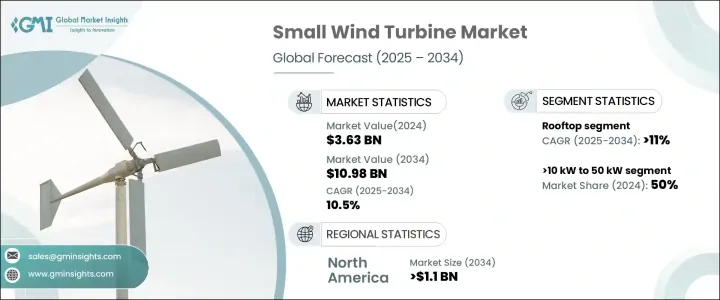
세계의 소형 풍력 터빈 시장 규모는 2024년 36억 3,000만 달러로, 2025년부터 2034년까지 CAGR 10.5%로 확대될 것으로 예측되고 있습니다.
이 시장은 개선된 기초 설계, 강화된 터빈 블레이드, 최적화된 회전 메커니즘 등 풍력 터빈 기술의 지속적인 발전으로 현저한 성장을 이루고 있습니다. 이러한 기술 혁신으로 인해 소형 풍력 발전 시스템의 효율과 비용 대비 성능이 향상되어 도시와 농촌에서 도입이 진행되고 있습니다.

개발 도상 지역에서는 소형 풍력 터빈이 분산형 에너지 발전을 위한 신뢰성이 높고 저렴한 솔루션으로 대두해 왔습니다. 첨단 재료, 공기역학, 컨트롤러 기술의 통합으로, 소형 풍력 시스템은 주택 소유자나 기업에 보다 매력적인 것이 되고 있습니다. 또한, 깨끗한 에너지에 대한 대처를 지원하는 금융 우대 조치나 정부 프로그램이, 시장 전망을 강화하고 있습니다.
| 시장 범위 | |
|---|---|
| 시작 연도 | 2024년 |
| 예측 연도 | 2025-2034년 |
| 시작 금액 | 36억 3,000만 달러 |
| 예측 금액 | 109억 8,000만 달러 |
| CAGR | 10.5% |
각국이 온실가스 배출량의 삭감과 재생가능 에너지 도입의 확대를 중시하는 가운데, 동산업은 기세를 늘리고 있습니다. 다양한 설치 유형 중에서도 옥상 설치형 소형 풍력 터빈이 인기를 모으고 있으며 2034년까지의 성장률은 11% 이상의 것으로 예측되고 있습니다. 이 시스템은 고고도의 바람을 이용해, 가정이나 기업, 지역사회에서 자가 발전을 가능하게 합니다.
독립형 소형 풍력 터빈도 특히 비전화 지역이나 농촌에서 수요가 높아지고 있습니다. 10-50kW의 소형 풍력 터빈은 2024년에는 시장 점유율의 50%를 차지할 것으로 예상됐으며, 이것은 주로 고립된 지역에서의 클린 에너지 수요 증가와, 농촌전화에 대한 규제 지원에 의한 것입니다.
북미의 소형 풍력 터빈 부문은 강력한 성장 태세에 있으며, 2034년에는 11억 달러를 돌파할 것으로 예측되고 있습니다. 중소규모의 풍력 터빈에 특화된 제조업체에 대한 지원은 시장 성장을 더욱 밀어주고, 지속적인 기술 혁신을 위한 좋은 비즈니스 환경을 만들어 가고 있습니다.
The Global Small Wind Turbine Market was valued at USD 3.63 billion in 2024 and is expected to expand at a CAGR of 10.5% between 2025 and 2034. The market is witnessing significant growth due to ongoing advancements in wind turbine technology, including improved foundation designs, enhanced turbine blades, and optimized rotation mechanisms. These innovations are making small wind systems more efficient and cost-effective, driving their adoption in both urban and rural settings. Manufacturers are actively developing standardized turbine solutions that offer better power output, improved environmental compatibility, and enhanced thermodynamic cycles, contributing to the industry's expansion.

In developing regions, small wind turbines are emerging as a reliable and affordable solution for decentralized energy generation. Their increasing adoption in off-grid areas is facilitating electrification in rural communities across Asia and Africa. The growing popularity of urban wind turbines, which capture wind energy from multiple directions while maintaining low noise levels, is further influencing market dynamics. The integration of advanced materials, aerodynamics, and controller technologies is making small wind systems more attractive to homeowners and businesses. Additionally, financial incentives and government programs supporting clean energy initiatives are strengthening the market outlook. The rising demand for micro turbines in residential applications is further boosting adoption, helping consumers lower electricity costs and achieve energy independence.
| Market Scope | |
|---|---|
| Start Year | 2024 |
| Forecast Year | 2025-2034 |
| Start Value | $3.63 Billion |
| Forecast Value | $10.98 Billion |
| CAGR | 10.5% |
The industry is gaining momentum as nations emphasize reducing greenhouse gas emissions and expanding renewable energy adoption. The increasing electrification of emerging economies and the global shift away from conventional power sources are key factors supporting market expansion. Among different installation types, rooftop small wind turbines are gaining traction, with projected growth exceeding 11% through 2034. These systems harness high-altitude wind currents, enabling homeowners, businesses, and communities to generate on-site electricity. Recent technological advancements are enhancing their efficiency while reducing noise and improving aesthetics, making them an appealing energy solution.
Standalone small wind turbines are also seeing rising demand, particularly in off-grid and rural locations. Technological improvements, declining costs, and the growing need for sustainable energy solutions are driving their adoption. Innovations in blade design, control mechanisms, and materials are improving turbine performance, making them a preferred choice for remote installations. Small wind turbines in the 10 kW to 50 kW range are expected to account for 50% of the market share in 2024, primarily due to increasing demand for clean energy in isolated regions and regulatory support for rural electrification. Their deployment in residential areas and the growing preference for off-grid solutions across homes, farms, and communities are reinforcing market trends.
North America small wind turbine sector is poised for strong growth, with projections indicating it will surpass USD 1.1 billion by 2034. Government policies promoting wind energy, coupled with funding for research and development, are fostering industry expansion. Support for manufacturers focused on small and medium-scale wind turbines is further reinforcing market growth, creating a favorable business environment for continued innovation.